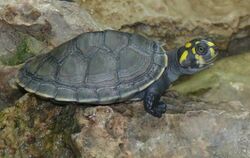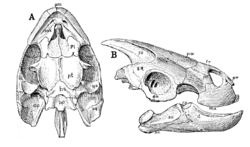Biology:Podocnemididae
| Podocnemididae | |
|---|---|

| |
| Yellow-spotted river turtle (Podocnemis unifilis) | |
| Scientific classification | |
| Domain: | Eukaryota |
| Kingdom: | Animalia |
| Phylum: | Chordata |
| Class: | Reptilia |
| Order: | Testudines |
| Suborder: | Pleurodira |
| Clade: | Podocnemidoidae |
| Family: | Podocnemididae Cope, 1868[1] |
| Extant genera | |
|
For fossil genera see text | |
| Synonyms | |
|
Podocnemidinae | |
Podocnemididae is a family of pleurodire (side-necked) turtles, once widely distributed. Most of its 20 genera and 30 species are now extinct. Seven of its eight surviving species are native to South America: the genus Peltocephalus, with only one species (P. dumerilianus, the big-headed Amazon River turtle); and the genus Podocnemis, with six living species of South American side-necked river turtles. There is also one genus native to Madagascar : Erymnochelys, the Madagascan big-headed turtle, whose single species E. madagascariensis.
Like other pleurodire turtles, podocs have a "side-necked" defensive posture, turning the head sideways to hide it under the shell. Another characteristic of pleurodires is that the pelvis is fused to the shell which prevents pelvic motion, making it difficult to walk on land.[2][3] Podocnemididae turtles live in aquatic environments and have shells streamlined to aid in swimming.[4]
Taxonomy and systematics

According to Ferreira et al. (2015), the family name derives from two Greek words: "podos" (foot) and "cnemis" (leg armor worn by Roman soldiers.)[5]
To clarify some closely related names:
- Podocnemidae (Baur, 1893) is an alternate but less commonly-used name for the same biological group as family Podocnemididae (Cope, 1868).[5]
- Epifamily Podocnemidinura: The family Podocnemididae has two sister families (Hamadachelys and Brasilemys); the relationship of these three families is sometimes recognized by grouping them as the epifamily Podocnemidinura.[6]
- Superfamily Podocnemidoidea: At a higher level yet, the epifamily Podocnemidinura is grouped with the family Bothremydidae to form the superfamily Podocnemidoidea.[6]
- Podocnemidinae: An earlier classification, rejected by Gaffney, treated Podocnemididae as a subfamily (Podocnemidinae) within the closely related family Pelomedusidae.[7])
According to Gaffney et al. (2011), the family Podocnemididae can be diagnosed from its cranial traits including "the unique possession of a cavum pterygoidei formed by the basisphenoid, pterygoid, prootic, and quadrate [bones], underlain by the pterygoid and basisphenoid."[8]
The pocnemid family dates to the late Cretaceous; it includes 20 genera and 30 species. Only three genera (and eight species) survive.[8]
The three living genera of Podocnemididae (two of them monotypic) are:
- Erymnochelys – Madagascan big-headed turtle
- Peltocephalus – big-headed Amazon River turtle
- Podocnemis – South American side-necked river turtles
Taxonomy
Fossils show that Podocnemidids were once found in Europe, Asia, North America, and Africa. Stupendemys lived around 5.5 million years ago in northern South America, and was the largest freshwater turtle with a carapace length of 2.4 metres, the largest of any known turtle and is the largest pleurodire known.[9]
Genera:
- Stem group taxa (Podocnemidoidae)
- †Brasilemys[10] Romualdo Formation, Brazil, Early Cretaceous (Albian)
- †Amabilis[11] São José do Rio Preto Formation, Brazil, Late Cretaceous (Santonian)
- †Hamadachelys Kem Kem Group, Morocco, Late Cretaceous (Cenomanian)
- †Portezueloemys Portezuelo Formation, Argentina, Late Cretaceous (Turonian)
- †Cambaremys Marília Formation, Brazil, Late Cretaceous (Maastrichtian)
- †Bauruemys Presidente Prudente Formation, Brazil, Late Cretaceous (Campanian)
- †Roxochelys Adamantina Formation, Brazil, Campanian
- Family †Peiropemydidae
- †Peiropemys Marília Formation, Brazil, Maastrichtian
- †Pricemys Marília Formation, Brazil, Maastrichtian
- †Lapparentemys Santa Lucía Formation, Bolivia, Paleocene
- †Yuraramirim[12] Adamantina Formation, Brazil, Campanian
- Family Podocnemididae (crown group)
- †Caninemys Northern South America, Miocene
- Subfamily Podocnemidinae
- †Cerrejonemys Cerrejón Formation, Colombia, Paleocene
- Podocnemis South America, Miocene-Recent
- Subfamily Erymnochelyinae
- †Gestemys Geste Formation, Argentina, Eocene
- †Stupendemys[8] Northern South America, Miocene
- †Carbonemys Cerrejón Formation, Colombia, Paleocene
- Peltocephalus Northern South America, Recent
- Erymnochelyini (formerly the "Erymnochelys group")
- †Apeshemys[13] (formerly "Podocnemis" aegyptiaca) Egypt, Early Miocene
- †Eocenochelus Eocene, Europe
- Erymnochelys Madagascar, Recent
- †Shetwemys[13] (formerly "Podocnemis" fajumensis) Jebel Qatrani Formation, Egypt, Oligocene Shumaysi Formation, Saudi Arabia, Oligocene
- †Turkanemys Kenya, Miocene-Pliocene
- †Kenyemys Kenya, Miocene-Pliocene
- †Mokelemys Democratic Republic of the Congo, Pliocene
- Stereogenyina
- †Stereogenys cromeri Qasr el Sagha Formation, Egypt, Late Eocene
- †Andrewsemys[14] (formerly "Stereogenys" libyca) Egypt, Late Eocene-Early Oligocene
- †Cordichelys Egypt, Late Eocene
- †Lemurchelys Moghara Formation, Egypt, Early Miocene
- †"Podocnemis" bramlyi Moghara Formation, Egypt, Early Miocene
- †Latentemys Egypt, Miocene
- †Bairdemys Late Oligocene-Miocene, Americas
- †Brontochelys Bugti Hills, Pakistan Early Miocene
- †Shweboemys Pliocene-Pleistocene, Myanmar
- †Piramys[15] India, Late Miocene
- Incertae sedis
- †Neochelys Eocene, Europe
- †"Stereogenys" podocnemoides Qasr el Sagha Formation, Egypt, Late Eocene
- †Dacquemys Birket Qarun Formation, Egypt, Late Eocene, Jebel Qatrani Formation, Egypt, Early Oligocene
- †Albertwoodemys Jebel Qatrani Formation, Egypt, Oligocene
- †Mogharemys Moghara Formation, Egypt, Early Miocene
- †Ragechelus[16] Farin-Doutchi Formation, Niger, Maastrichtian
- Subfamily Podocnemidinae
References
- ↑ Cope, Edward Drinker (1868). "On the Origin of Genera". Proceedings of the Academy of Natural Sciences of Philadelphia 20 (106): 242–300. "Three phalanges on most digits; Zygomatic arch; no parieto-mastoid .. Podocnemididae. Temporal fossa overroofed by parietal.. Podocnemis.".
- ↑ Wise, Taylor B.; Stayton, C. Tristan (2017-03-01). "Side-necked Versus Hidden-necked: A Comparison of Shell Morphology Between Pleurodiran and Cryptodiran Turtles". Herpetologica 73 (1): 18. doi:10.1655/HERPETOLOGICA-D-15-00038. ISSN 0018-0831.
- ↑ Sánchez-Villagra, Marcelo R.; Winkler, Jasmin D.; Wurst, Linda (2007-04-19). "Autopodial skeleton evolution in side-necked turtles (Pleurodira): Pleurodire autopodial evolution" (in en). Acta Zoologica 88 (3): 199–209. doi:10.1111/j.1463-6395.2007.00267.x. http://doc.rero.ch/record/16387/files/PAL_E3478.pdf.
- ↑ Mayerl, Christopher J.; Brainerd, Elizabeth L.; Blob, Richard W. (2016-06-23). "Pelvic girdle mobility of cryptodire and pleurodire turtles during walking and swimming". The Journal of Experimental Biology 219 (17): 2650–2658. doi:10.1242/jeb.141622. ISSN 0022-0949. PMID 27340204.
- ↑ 5.0 5.1 Ferreira, Gabriel S.; Rincón, Ascanio D.; Solórzano, Andrés; Langer, Max C. (2015). "The last marine pelomedusoids (Testudines: Pleurodira): a new species of Bairdemys and the paleoecology of Stereogenyina". PeerJ 3: 1–29. doi:10.7717/peerj.1063. PMID 26157628. PMC 4493680. https://peerj.com/articles/1063.pdf. Retrieved 2019-02-20.
- ↑ 6.0 6.1 Gaffney, E. S.; Tong, H.; Meylan, P. A. (2006-11-17). "Evolution of the side-necked turtles: The families Bothremydidae, Euraxemydidae, and Araripemydidae". Bulletin of the American Museum of Natural History (New York: American Museum of Natural History) 300: 1–700. doi:10.1206/0003-0090(2006)300[1:EOTSTT2.0.CO;2]. http://doc.rero.ch/record/15686/files/PAL_E2036.pdf. "The relationships of the family Podocnemididae to its sister taxa Hamadachelys and Brasilemys are recognized by placing them in the epifamily Podocnemidinura. The epifamily Podocnemidinura is the sister group to the family Bothremydidae, and together they form the superfamily Podocnemidoidea.".
- ↑ Fritz Jürgen Obst (1998). "Pelomedusinae". Encyclopedia of Reptiles and Amphibians. San Diego: Academic Press. pp. 112–113. ISBN 0-12-178560-2.
- ↑ 8.0 8.1 8.2 Eugene S. Gaffney; Peter A. Meylan; Roger C. Wood; Elwyn Simons; Diogenes De Almeida Campos (2011). "Evolution of the Side-Necked Turtles: The Family Podocnemididae". Bulletin of the American Museum of Natural History 350: 1–237. doi:10.1206/350.1. "The family Podocnemididae consists of 20 genera and 30 species considered here as valid and diagnosable by cranial characters. Three of these genera and eight species persist into the Recent fauna, barely reflecting the evolutionary diversity and distribution of the group. The family extends from the late Cretaceous to the Recent and occurs in North and South America, Europe, Asia, and Africa.".
- ↑ Cadena, E.-A.; Scheyer, T. M.; Carrillo-Briceño, J. D.; Sánchez, R.; Aguilera-Socorro, O. A; Vanegas, A.; Pardo, M.; Hansen, D. M. et al. (February 2020). "The anatomy, paleobiology, and evolutionary relationships of the largest extinct side-necked turtle" (in en). Science Advances 6 (7): eaay4593. doi:10.1126/sciadv.aay4593. ISSN 2375-2548. PMID 32095528.
- ↑ De Lapparent, France. "The oldest pre-Podocnemidid turtle (Chelonii, Pleurodira), from the Early Cretaceous, Ceara State, Brasil, and its environment". Treballs del Museu de Geologia de Barcelona 9: 43–95. https://www.researchgate.net/publication/39116427. Retrieved December 4, 2021. "In the Podocnemidoidea, Brasilemys n.g. represents the earliest known specimen of the Podocnemidoidae, immediately after the divergence of the Bothremydidae. It is part of the formidable radiation in the Pelomedusoides which occurs during the early Cretaceous when South America separated from Africa.".
- ↑ Hermanson, Guilherme; Iori, Fabiano V.; Evers, Serjoscha W.; Langer, Max C.; Ferreira, Gabriel S. (2020). "A small podocnemidoid (Pleurodira, Pelomedusoides) from the Late Cretaceous of Brazil, and the innervation and carotid circulation of side-necked turtles" (in en). Papers in Palaeontology 6 (2): 329–347. doi:10.1002/spp2.1300. ISSN 2056-2802.
- ↑ Ferreira, Gabriel S.; Iori, Fabiano V.; Hermanson, Guilherme; Langer, Max C. (September 2018). "New turtle remains from the Late Cretaceous of Monte Alto-SP, Brazil, including cranial osteology, neuroanatomy and phylogenetic position of a new taxon" (in en). PalZ 92 (3): 481–498. doi:10.1007/s12542-017-0397-x. ISSN 0031-0220. http://link.springer.com/10.1007/s12542-017-0397-x.
- ↑ 13.0 13.1 Pérez-García, A. (2021). "New shell information and new generic attributions for the Egyptian podocnemidid turtles "Podocnemis" fajumensis (Oligocene) and "Podocnemis" aegyptiaca (Miocene)". Fossil Record 24 (2): 247–262. doi:10.5194/fr-24-247-2021.
- ↑ Pérez-García, Adán (2019-03-16). "New information and establishment of a new genus for the Egyptian Paleogene turtle 'Stereogenys' libyca (Podocnemididae, Erymnochelyinae)". Historical Biology 31 (3): 383–392. doi:10.1080/08912963.2017.1374383. ISSN 0891-2963. https://doi.org/10.1080/08912963.2017.1374383.
- ↑ Ferreira, Gabriel S.; Bandyopadhyay, Saswati; Joyce, Walter G. (2018-11-15). "A taxonomic reassessment of Piramys auffenbergi, a neglected turtle from the late Miocene of Piram Island, Gujarat, India" (in en). PeerJ 6: e5938. doi:10.7717/peerj.5938. ISSN 2167-8359. PMID 30479901.
- ↑ Broin, France de Lapparent de; Chirio, Laurent; Bour, Roger (October 2020). "The oldest erymnochelyine turtle skull, Ragechelus sahelica n. gen., n. sp., from the Iullemmeden basin, Upper Cretaceous of Africa, and the associated fauna in its geographical and geological context". Geodiversitas 42 (25): 455–484. doi:10.5252/geodiversitas2020v42a25. ISSN 1280-9659.
External links
Wikidata ☰ Q133885 entry
 |
